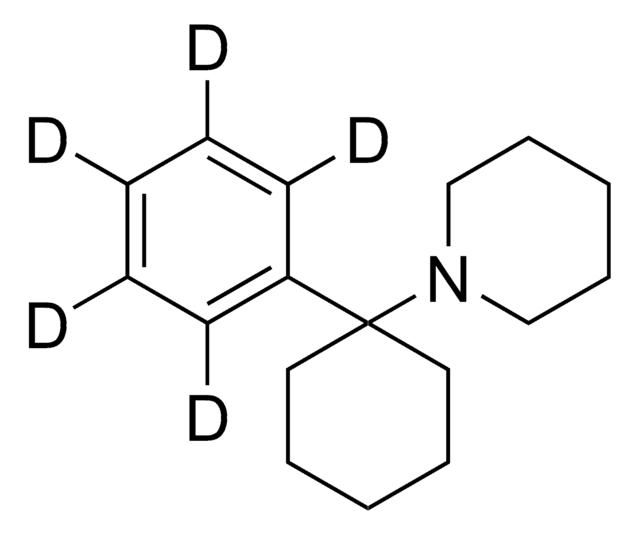P3029
Phencyclidine hydrochloride
Sinonimo/i:
1-(1-Phenylcyclohexyl)piperidine hydrochloride, PCP hydrochloride
About This Item
Prodotti consigliati
Forma fisica
powder
Livello qualitativo
Controllo stupefacenti
USDEA Schedule II; Home Office Schedule 2; stupéfiant (France); kontrollierte Droge in Deutschland; regulated under CDSA - not available from Sigma-Aldrich Canada; psicótropo (Spain); Decreto Lei 15/93: Tabela IIA (Portugal)
Solubilità
H2O: 11.2 mg/mL
0.1 M HCl: 18.4 mg/mL
methanol: 30 mg/mL
Stringa SMILE
Cl.C1CCN(CC1)C2(CCCCC2)c3ccccc3
InChI
1S/C17H25N.ClH/c1-4-10-16(11-5-1)17(12-6-2-7-13-17)18-14-8-3-9-15-18;/h1,4-5,10-11H,2-3,6-9,12-15H2;1H
BUAJNGPDPGKBGV-UHFFFAOYSA-N
Cerchi prodotti simili? Visita Guida al confronto tra prodotti
Azioni biochim/fisiol
Caratteristiche e vantaggi
Avvertenze
Danger
Indicazioni di pericolo
Consigli di prudenza
Classi di pericolo
Acute Tox. 3 Oral - STOT SE 3
Organi bersaglio
Central nervous system
Codice della classe di stoccaggio
6.1C - Combustible acute toxic Cat.3 / toxic compounds or compounds which causing chronic effects
Classe di pericolosità dell'acqua (WGK)
WGK 3
Punto d’infiammabilità (°F)
Not applicable
Punto d’infiammabilità (°C)
Not applicable
Dispositivi di protezione individuale
Eyeshields, Faceshields, Gloves, type P2 (EN 143) respirator cartridges
Certificati d'analisi (COA)
Cerca il Certificati d'analisi (COA) digitando il numero di lotto/batch corrispondente. I numeri di lotto o di batch sono stampati sull'etichetta dei prodotti dopo la parola ‘Lotto’ o ‘Batch’.
Possiedi già questo prodotto?
I documenti relativi ai prodotti acquistati recentemente sono disponibili nell’Archivio dei documenti.
Il team dei nostri ricercatori vanta grande esperienza in tutte le aree della ricerca quali Life Science, scienza dei materiali, sintesi chimica, cromatografia, discipline analitiche, ecc..
Contatta l'Assistenza Tecnica.
